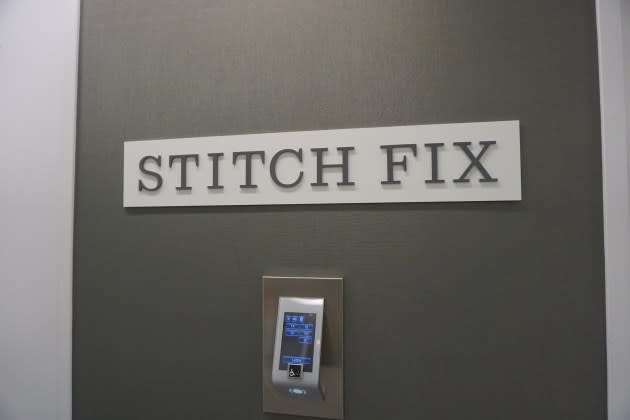Stitch Fix’s Fiscal Q1: ‘Worst Q1 Performance in 5 Years,’ Analyst Says

Stitch Fix hasn’t managed to sew up its financial comeback, as the tech-driven styling service and e-commerce platform reported larger-than-expected losses and a revenue miss for its first fiscal quarter of 2023 on Tuesday. Eyeing a lower projected forecast to boot, Wall Street saw the stock slump in after-hours trading.
The fashion company posted revenue of $455.6 million, which was not only short of the $459.4 million analysts estimated, but marked a notable 22 percent year-over-year plummet. Its quarterly net loss clocked in at 50 cents per share, exceeding the 47 cents per share expected, with active clients of 3.7 million showing a decline of 471,000 or an 11 percent drop compared to last year.
More from WWD
Naturally chief executive officer Elizabeth Spaulding focused on the positives: “This quarter we made meaningful progress on our transformation journey despite a difficult macro environment,” she said in a statement. “Through diligent cost savings and efficiencies we beat our adjusted EBITDA expectations for Q1 and have improved our adjusted EBITDA [earnings before interest, taxes, depreciation and amortization] guidance for FY23 [fiscal-year 2023].”
In a call with analysts, Spaulding offered more context, primarily to emphasize a challenging macroeconomic environment, which has dogged the broader retail and technology sectors.
“As the macroeconomic environment continues to be uncertain, we are now further balancing the need to optimize our cost structure against achieving the long-term growth objectives of the business,” she explained. “We are confident in this approach and are determined to use this moment as a catalyst to create a leaner, more nimble and profitable Stitch Fix, while continuing to enhance the experience for our clients.”
Stitch Fix has been focusing optimizing efficiency, streamlining costs and analyzing its marketing strategy, as well as while amping up what differentiates the service — namely “fit, discovery and human relationships,” she said.
Whether that will be enough remains to be seen, and some analysts remain concerned.
Neil Saunders, managing director of GlobalData, noted that the plunging revenue showed “a far faster pace of decline than the erosion of the past two quarters.” Sales didn’t merely drop year-over-year, but also when compared to the same period in 2020. The $55.9 million loss this quarter makes for “the worst first quarter performance since the company started reporting numbers [five] years ago,” he said.
While it did outperform its pre-pandemic level, it wasn’t by much, edging it out by just 2.4 percent. According to Saunders, that was ”a paltry rate of increase given the explosion in consumer spending on apparel over this period — especially that made online.”
As for those macroeconomic factors, their effects can’t be overstated, as they complicate one retail earnings report after another. But, Saunders noted, that’s less of an excuse than reason for ongoing concern: Stitch Fix is a discretionary expense that consumers could easily skip as times get tougher. “And with the economy set to tighten over the months ahead,” he said, “our concern is that there could be a further and faster erosion of customers stretching into the next few quarters.”
The company likely sees that as well. For the second quarter, it projects a revenue range of $410 million to $420 million, not the $445 million analysts expected. By July 2023, at the end of the fiscal year, Stitch Fix believes net revenue will be between $1.6 billion and $1.7 billion, with adjusted earnings ranging between a loss of $10 million to income of $10 million.
Wall Street saw fit to send shares down 4 percent in after-hours trading. Over the last year, Stitch Fix stock has been down some 85 percent.
It will take more than cutting costs to climb out of this hole, and Spaulding knows it. On the call, the CEO made it clear that she sees her platform’s differentiation as the key to drive the business forward.
For instance, customers want help to get more value out their existing wardrobes, she explained, then pointed to a number of features, such as outfit-based feeds, weekly outfits emails and personalized dynamic content that shows people how to wear new arrivals — all of which stoke high conversion rates. Over the year, it has also experimented with episodic or quarterly promotional events, a new opportunity afforded by its Freestyle direct-buy business, and it’s making more use of influencers. When it comes to selection, the company added more than 80 national brands alongside its Stitch Fix-exclusive labels, and broadened into new categories like footwear, outerwear and dresses.
“Some of the other work that we’re focused on in the background are things like a unified data platform….Our infrastructure was built very rapidly to scale our Fix [subscription] business into multiple lines of business like women’s, men’s, kids, in the U.K.,” Spaulding continued. “It didn’t have the foresight to know we’d launch Freestyle or the foresight to say, ‘Let’s get into a lot of different product categories.’
“So we’re essentially slowing down a bit to speed up in the future by preparing our infrastructure…”
But for Saunders, that may point to how complex and expensive the platform is to operate. Meanwhile, diversifying the styling or subscription model with Freestyle direct-buy didn’t alleviate the slowdown in the core business, as hoped.
“The problem here is that when the curation element is removed, Stitch Fix is not particularly different from any other retailer of fashion,” he explained. “On top of this, most consumers have pulled back on the volume of clothes they buy, so Stitch Fix is trying to sell into a more muted market — and one where promotions and discounts from other retailers abounds.”
